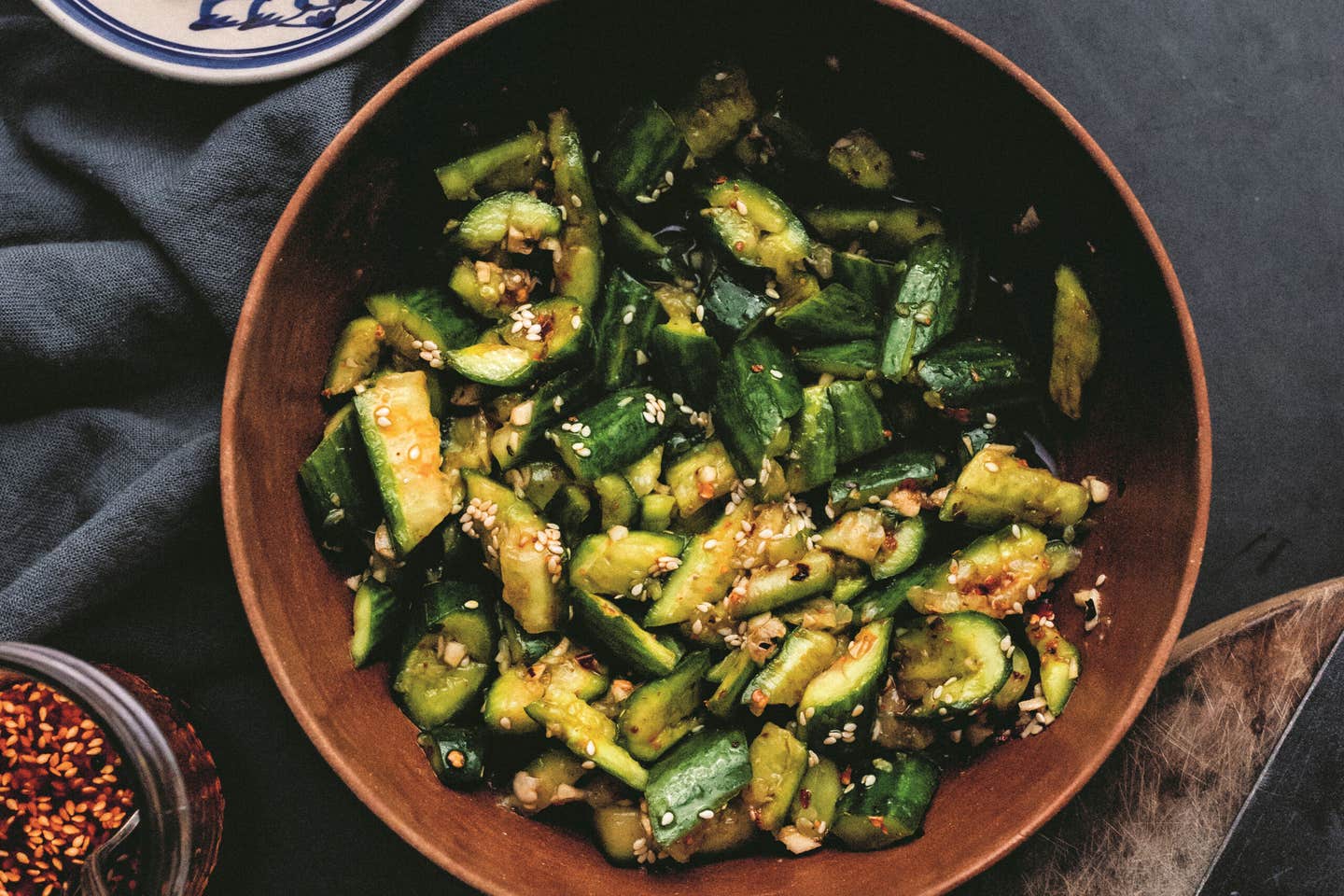
Hannah Che on the Myths of Vegan Chinese Cuisine
The cookbook author walks us through what she orders at Chinese restaurants, plus the one cooking tool you need to make plants shine.
This story is brought to you by SAVEUR Cookbook Club, our passionate community of food-loving readers from around the globe celebrating our favorite authors and recipes. Join us as we cook through a new book every two months, and share your food pics and vids on social media with the hashtags #SAVEURCookbookClub and #EatTheWorld.
After making the decision to become vegan, Hannah Che nearly cried when she visited China’s vegetarian restaurants. Not only were establishments that served plant-based food plentiful in all the Chinese cities she visited, but the dishes she ate were also bursting with flavor. She knew she wanted to learn more about the country’s long and rich history of vegetarian cooking. So, in 2019, Che enrolled at a culinary school in Guangzhou, a city in southern China famed for its fresh and delicate Cantonese cuisine. The experience ended up being a pivotal stage in her plant-based journey: The training shed light on the Buddhist ethos underpinning much of the country’s vegetarian cooking and also taught her simple techniques to amplify the flavors of vegetables. Now, she’s sharing her learnings with the world in her debut cookbook, The Vegan Chinese Kitchen: Recipes and Modern Stories from a Thousand-Year-Old Tradition.
We sat down with Che to chat about what she considers to be myths and misconceptions about Chinese cooking, why she embraces mock meats, and what her teachers in Guangzhou taught her about the art of plant-based cooking.
The following has been condensed and edited for clarity.
How did you make the decision to become vegan?
In sophomore year of college, I read the book Eating Animals by Jonathan Safran Foer. I was living in a dorm, eating college cafeteria food, and was just really disconnected from anything to do with cooking. That book made me aware of the larger picture behind the way our food is produced, especially animal products. Foer does a really good job, I think, of not being judgmental or condemning the way we eat, but just explaining how our food systems wound up intertwined with factory farming—government-subsidized, profit-driven food production that has no concern for our health or for treating animals humanely. I was at home over summer break, and the moment I finished this book, I was like, “Mom, I think I need to become vegan.”
What drew you to cooking plant-based Chinese food specifically?
My perception of Chinese food when I was growing up was very confined to what my parents cooked. After I spent time traveling in China, I realized there were so many vegetarian restaurants in all the cities I visited. The dishes were so beautifully presented and so creative, and I wanted to find out more about the philosophy and history behind them. I learned that a lot of vegetarian dishes in China have ancient roots in temple cuisine—food that monks make and serve in monasteries, including for visitors. The dishes are free of animal products because not inflicting harm on any living creatures is an important Buddhist ethos. It’s very much a compassionate way of eating.

In your opinion, what is the biggest misconception many Americans have about vegan Chinese food?
I think it’s misrepresented in two ways. The first is that you can’t find vegan dishes when going out to eat in China. I think that perception comes from the fact that most popular Chinese takeout dishes in the West are meat-heavy. A lot of people aren’t aware of the fact that most Chinese families’ home cooking is very much vegetable-centered. The word for dishes is cài, which actually means vegetables. The second misconception is that vegan Chinese dishes are just “regular” dishes that you take the meat out of.
It’s not that you’re making vegan versions of meat dishes—because many of the dishes in your book never had meat to begin with, right?
Yes. From the food of Sichuan to the food of Shanghai, there are so many inherently plant-based dishes in these regional cuisines. I really don’t like the word “veganize” because the connotation is that you’re like this outsider coming in and taking a traditional dish and altering it because the original way wasn’t good enough. I don’t think about vegan Chinese food as veganizing Chinese dishes. It’s more just discovering the abundance of vegetarian cooking that already exists.
Why did you decide to train at the Guangzhou Vegetarian Culinary Institute in China in 2019?
Cantonese cuisine, just by nature of the climate in Guangdong Province, has such an abundance of fresh produce and traditionally uses a lot of leafy greens. I’m not Cantonese—my parents are from northern China—so going to Guangzhou and learning from the chefs there was very humbling for me. They taught me a different way of cooking that is very, very simple. You’re cooking with just one wok, and the variables really are just the types of fresh vegetables that you’re using and the aromatics, whether it’s slices of ginger or dried chiles.

What kind of Chinese dishes are your go-tos when you eat out at restaurants?
My go-to is usually an eggplant dish, or a stir-fry, or something with tofu. A lot of the time, vegetable dishes are automatically vegan because, for the most part, Chinese cuisine doesn’t utilize a lot of dairy. Of course, be mindful that sometimes vegetable dishes are made with chicken broth or lard.
Mock meats appear in a lot of plant-based Chinese dishes. How do you feel about them?
There’s a kind of negative perception of imitation meat among a lot of vegans in the U.S. Many people feel, “I don’t want to eat animal products, so why would I go out and eat vegan meats?” But that kind of thinking isn’t a very generous way of thinking about the food that we eat. These products are mostly for non-vegetarians who are just trying to reduce their intake of animal products. You have these very familiar textures that allow people to cook what they cook usually, but with substitute products. If they get anyone to eat less meat, I’m all for that.
What are the cultural connotations of mock meats in China’s vegetarian tradition?
Along the same lines as new imitation meats today, Chinese mock meats also evolved as a way to be more inclusive at the table. In Chinese culture, dishes can be highly symbolic—chicken or fish might represent prosperity or good luck. Monasteries want guests to feel welcome and honored, and so present them with elaborate and symbolic dishes that guests would be familiar with, just without the animal products. This tradition of mock meats is being continued in the contemporary restaurant world. Chefs are doing really creative things with plant proteins like tofu, too, which I think is influenced by the parallel growing market of, like, Beyond Meat and Impossible Foods. The perception of meat substitutes is changing. There’s this interesting co-mingling of the old with the new.
Keep Reading
Continue to Next Story










